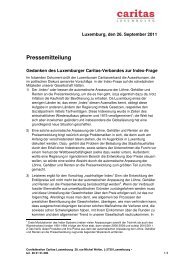Sozialalmanach - Caritas Luxembourg
Sozialalmanach - Caritas Luxembourg
Sozialalmanach - Caritas Luxembourg
You also want an ePaper? Increase the reach of your titles
YUMPU automatically turns print PDFs into web optimized ePapers that Google loves.
economy remained strong – although this was largely thanks to the housing bubble –<br />
and companies diligently repaired their balance sheets. This cheap money created a very<br />
competitive environment for financial institutions, which could only get high returns if<br />
they made ever-riskier investments.<br />
Global imbalances<br />
Macro imbalance in trade has accelerated dramatically over the past ten to fifteen<br />
years, partly as a result of loose US monetary policy. Asian emerging economies and<br />
the oil-exporting countries accumulated large current account surpluses, and these were<br />
matched by large current account deficits in the US, as well as the UK, Ireland, and Spain.<br />
A key driver of these imbalances was the high savings rates in countries like China. The<br />
run-up to the crisis should actually be traced back to the 1997 Asian financial market<br />
crash. Following this disaster, Asian governments (and citizens) felt increasingly insecure<br />
and ramped up their reserves – primarily in US dollars – in order to avoid becoming<br />
vulnerable to such a scenario in the future. This exacerbated the US debt burden, further<br />
perpetuating the trade imbalance.<br />
Lax financial regulation<br />
Loose monetary policy and the international trade imbalance were compounded by<br />
a third factor: the deregulation of the financial sector. With the liberalisation of capital<br />
markets, finance became global, but regulation remained national. In addition, throughout<br />
the neo-liberal epoch, even domestic financial markets were systematically deregulated,<br />
allowing financial innovations to evolve unchecked. As the financial sector grew and became<br />
truly global, insufficient latitude was reserved for domestic government regulation and<br />
international supervision 34 . Financial sector deregulation allowed the macro-imbalances in<br />
savings rates to stimulate a massive wave of financial innovation, focused on the origination,<br />
packaging, trading and distribution of derivatives, credit default swaps, and other securitised<br />
credit instruments. Since the mid-1990s there has been huge growth in the value of credit<br />
securities, an explosion in the complexity of the securities sold, and a related explosion of<br />
the volume of credit derivatives, enabling investors and traders to hedge underlying credit<br />
exposures. As securitisation grew in importance from the 1980s on, this development was<br />
lauded as a means to reducing banking system risks and to cutting the total cost of credit<br />
intermediation. The politics of international deregulation, together with computer-based<br />
finance mathematics, finally extricated the capacity to produce money by credit from<br />
public control – which to some extent at least had tied it to production and consumption<br />
34 Posner (2009).<br />
163








